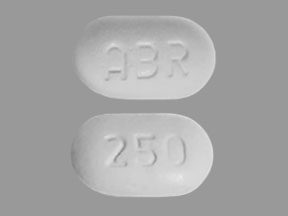Abiraterone Dosage
Medically reviewed by Drugs.com. Last updated on Sep 5, 2025.
Applies to the following strengths: 250 mg; 500 mg; 125 mg
Usual Adult Dose for:
Additional dosage information:
Usual Adult Dose for Prostate Cancer
Metastatic CRPC:
- Regular formulation: 1000 mg orally once daily (in combination with methylprednisolone 5 mg orally 2 times daily)
- Micronized formulation: 500 mg orally once daily (in combination with methylprednisolone 4 mg orally 2 times daily)
Metastatic high-risk CSPC:
- Regular formulation: 1000 mg orally once daily (in combination with methylprednisolone 5 mg orally once daily)
Comments:
- Patients receiving this drug should also receive a gonadotropin-releasing hormone (GnRH) analog concurrently or should have had bilateral orchiectomy.
- Different abiraterone acetate formulations have different indications and different dosing. Refer to the manufacturer product information before prescribing this drug.
Uses:
In combination with prednisone for the treatment of patients with:
- Metastatic castration-resistant prostate cancer (CRPC)
- Metastatic high-risk castration-sensitive prostate cancer (CSPC)
Renal Dose Adjustments
No adjustment recommended.
Liver Dose Adjustments
REGULAR FORMULATION:
- Mild liver impairment (Child-Pugh A): No adjustment recommended.
- Moderate liver impairment (Child-Pugh B): Reduce the starting dose to 250 mg orally once a day
- Severe Liver Dysfunction (Child-Pugh C): Not recommended.
- Interrupt therapy, then restart at a reduced dose of 750 mg orally once a day following return of liver function tests to baseline or to ALT and AST 2.5 x ULN or less and total bilirubin 1.5 x ULN or less.
- For patients who resume therapy, monitor serum transaminases and bilirubin at a minimum of every 2 weeks for 3 months and monthly thereafter.
- If hepatotoxicity recurs at 750 mg/day, then restart at a reduced dose of 500 mg orally once a day following return of liver function tests to baseline or to ALT and AST 2.5 x ULN or less and total bilirubin 1.5 x ULN or less.
- Discontinue therapy if hepatotoxicity recurs at 500 mg/day.
- Permanently discontinue therapy in patients who develop a concurrent elevation of ALT greater than 3 x ULN and total bilirubin greater than 2 x ULN in the absence of biliary obstruction or other causes responsible for the concurrent elevation.
MICRONIZED FORMULATION:
- Mild liver impairment (Child-Pugh A): No adjustment recommended.
- Moderate liver impairment (Child-Pugh B): Reduce starting dose to 125 mg orally once a day; monitor ALT, AST, and bilirubin prior to the start of therapy, every week for the first month, every 2 weeks for the following 2 months of therapy and monthly thereafter. If elevations in ALT and/or AST greater than 5 x upper limit of normal (ULN) or total bilirubin greater than 3 x ULN occur in patients with baseline moderate hepatic impairment, discontinue therapy permanently.
- Severe liver impairment (Child-Pugh C): Not recommended.
- Interrupt therapy, then restart at a reduced dose of 375 mg orally once a day following return of liver function tests to baseline or to ALT and AST 2.5 x ULN or less and total bilirubin 1.5 x ULN or less. For patients who resume therapy, monitor serum transaminases and bilirubin at a minimum of every 2 weeks for 3 months and monthly thereafter.
- If hepatotoxicity recurs at 375 mg/day, then restart at a reduced dose of 250 mg orally once a day following return of liver function tests to baseline or to ALT and AST 2.5 x ULN or less and total bilirubin 1.5 x ULN or less.
- Discontinue therapy if hepatotoxicity recurs at 250 mg/day.
- Permanently discontinue therapy in patients who develop a concurrent elevation of ALT greater than 3 x ULN and total bilirubin greater than 2 x ULN in the absence of biliary obstruction or other causes responsible for the concurrent elevation.
Dose Adjustments
REGULAR FORMULATION:
CONCOMITANT USE OF STRONG CYP450 3A4 INDUCER:
- Avoid concomitant use if possible.
- If concomitant use is necessary, increase the dosing frequency to 1000 mg orally 2 times a day during the coadministration period.
- Return to the previous dosing frequency once the strong CYP450 3A4 inducer is discontinued.
- Avoid concomitant use if possible.
- If concomitant use is necessary, consider a dose reduction of the CYP450 2D6 substrate during the coadministration period.
MICRONIZED FORMULATION:
CONCOMITANT USE OF STRONG CYP450 3A4 INDUCER:
- Avoid concomitant use if possible.
- If concomitant use is necessary, increase the dosing frequency to 5000 mg orally 2 times a day during the coadministration period.
- Return to the previous dosing frequency once the strong CYP450 3A4 inducer is discontinued.
- Avoid concomitant use if possible.
- If concomitant use is necessary, consider a dose reduction of the CYP450 2D6 substrate during the coadministration period.
Precautions
CONTRAINDICATIONS:
- None
Safety and efficacy have not been established in patients younger than 18 years.
Consult WARNINGS section for additional precautions.
Dialysis
Data not available
Other Comments
Administration Advice:
- NOTE: Different products are not interchangeable.
- This drug should be taken on an empty stomach at least one hour before or at least two hours after a meal with the exception of the micronized formulation which may be taken with or without food.
- This drug should be swallowed whole with water.
- Drug tablets should not be crushed or chewed.
- Pregnant women should not handle this drug without protection (e.g., gloves).
- In the event of a missed dose, the missed dose should be skipped and therapy should be resumed the following day with the usual daily dose.
Monitoring:
- Cardiovascular: Cardiac function
- Endocrine: Blood pressure, serum potassium, fluid retention, signs/symptoms of adrenocortical insufficiency
- Hepatic: ALT, AST, bilirubin
- Metabolic: Blood sugar (in diabetic patients)
Frequently asked questions
More about abiraterone
- Check interactions
- Compare alternatives
- Pricing & coupons
- Reviews (44)
- Drug images
- Side effects
- During pregnancy
- Drug class: miscellaneous antineoplastics
- En español
Patient resources
Other brands
Professional resources
Other brands
Related treatment guides
See also:
Further information
Always consult your healthcare provider to ensure the information displayed on this page applies to your personal circumstances.


